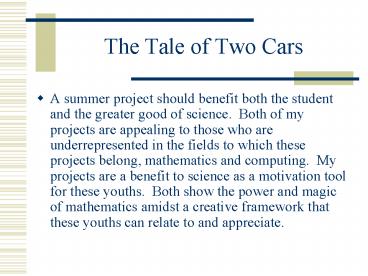The Tale of Two Cars - PowerPoint PPT Presentation
1 / 12
Title:
The Tale of Two Cars
Description:
Multibody, Dynamic Model of Modified 'Lowrider' Automobile Suspension. Setting up the Problem ... To model the dynamics and forces of a lowrider car ... – PowerPoint PPT presentation
Number of Views:65
Avg rating:3.0/5.0
Title: The Tale of Two Cars
1
The Tale of Two Cars
- A summer project should benefit both the student
and the greater good of science. Both of my
projects are appealing to those who are
underrepresented in the fields to which these
projects belong, mathematics and computing. My
projects are a benefit to science as a motivation
tool for these youths. Both show the power and
magic of mathematics amidst a creative framework
that these youths can relate to and appreciate.
2
Multibody, Dynamic Model of Modified Lowrider
Automobile Suspension
3
Setting up the Problem
4
(No Transcript)
5
Uniqueness of my model
- Though there exists a wide variety of suspension
models, my approach is unique in that I do not
make the standard assumption that the tires do
not leave the ground - This means that I am not allowed to say all
forces are zero when the car is equilibrium, but
rather that all forces are opposite and equal.
That is gravity and contact is considered. This
is actually always the case, but unnecessary if
the tires are always in contact with the ground.
6
ms zcg - Ws Ffds Ffps Fbds Fbps ?Mx -
We re rfs ( Ffds Ffps ) - rb Wb rt Wt
rbs (Fbds Fbps) ?My rx/2 ( Ffds Fbds)
rx/2 ( Ffps Ffps ) Ffds Kfs ( ?s
zfdw zfds ) B (zfdw zfds) Fh Ffps
Kfs ( ?s zfpw zfps ) B (zfpw zfps) Fh
Fbds Kbs ( ?s zbdw zbds ) B (zbdw
zbds) Fh Fbps Kbs ( ?s zbpw zbps )
B (zbpw zbps) Fh mus zfdw Kfw (
?w rw zfdw ) Ffds mus g mus zfpw
Kfw ( ?w rw zfpw ) Ffps mus g mus
zbdw Kbw ( ?w rw zbdw ) Fbds mus g
mus zbpw Kbw ( ?w rw zbpw ) Fbps mus
g ?x I-1 ?Mx ?y ?My
7
- ms sprung mass
- mus unsprung mass
- Ws sprung weight
- We engine weight
- Wb body/chassis weight
- Wt trunk weight
- Ffds Force from front driver suspension system
- Ffps Force from front passenger suspension
system - Fbds Force from back driver suspension system
- Fbps Force from back passenger suspension
system - Fh - Hydraulic impulse force
- ?s - suspension spring free length
- ?w - tire spring free length
- Kfs front suspension spring constant
- Kbs - back suspension spring constant
- B - Damping ratio
8
Specifics and Assumptions
- The car body/chassis is represented by a
rectangular box with a given mass density. - The engine and trunk(which carries a heavy load
due to the hydraulic system and extra batteries)
are represented by point masses. - The wheel/suspension system is given an
independent degree of freedom in the z direction. - The suspension link is also given a degree of
freedom in the x, y and z directions, however
only the z direction affects the outcome of the
differential equations. - The center of gravity is given a degree of
freedom in the x, y, and z directions, and a
moment about the x and y, but not the z.A - All force evaluations are enforced at the center
of gravity about the car. However the
Differential equations are focused on the
position of each suspension link. Therefore the
car is repositioned after every time step of
solving
9
Applications
- To model the dynamics and forces of a lowrider
car - The same model can be used for off road vehicles
(Rice mini-baja, for example) in that the tires
of an off road vehicle is likely to leave the
ground given extreme conditions - To capture the imaginations of underrepresented
youths to what math can do. The end idea of the
project is to put together a visual output of the
simulation with some interface and deliver this
over the internet to those targeted youths
10
Solving the Problem
- The main benefit that I receive out of this
project is a study of numerical methods and their
approach to solving different kinds of problems.
My second benefit is an increased ability and
confidence of using computer codes to solve my
problems - My first method of solving the problem is a basic
approach of the Rieman sum method of integration
over a constant time step.
11
Future Research and Direction
- Once my Rieman sum method and given equations
return agreeable results, my focus of research
will be focused on optimizing my code,
specifically my numerical method - I will study other methods of solving
differential equations (Eulers method and
variations, Runge-Kutta, etc.) - I will also focus on finding an optimal time step
variation function.
12
Acknowledgements
- Matthias Heinkenschloss Faculty Advisor
- Victor Udoewa Graduate Mentor
- Edward Gonzalez Graduate Mentor
- AGEP






























![READ [PDF] Little Angels: 2nd Edition (Little Angels + Two) PowerPoint PPT Presentation](https://s3.amazonaws.com/images.powershow.com/10050018.th0.jpg?_=20240607085)
